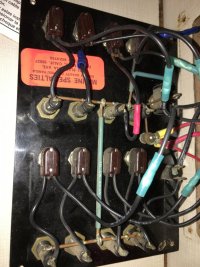Markvone was writing about the rotating 1-2-Both-Off. Easy to test by disconnecting all the wires on the back, clean the copper at each terminal, attach an ohmmeter/multimeter, and check each position for continuity, open circuit, or amount of resistance. I'm sure there is a spec for allowable resistance when a position is selected, but on a typical hand held meter where you are already dealing with resistance of the probes, anything more than probably .2 ohms would be suspect. Clean each of the wire terminals and connections before re-assembling.
Observations on your photo:
1. I haven't seen soldered copper rod like that in a long time. It actually is in pretty good condition, it is just one OLD fuse panel.
2. The master switch should be the one above the terminal with the red wires. Turn off the battery switch, pull ALL the fuses and use the ohm/multimeter to make sure that old switch still works. It's your most used switch, OLD, and a single point for the type of failure you described if the actual battery switch tested OK.
3. LIGHTLY press each solder connection at each of the fuse casings to look for a cracked one. Same at the master switch.
4. The master switch has what appears to be one connection to it, which is the solid buss bar with the blue insulation. If the other wire really is not attached (probably from opening the panel), then there's the answer to your original question about why the panel has no juice.
5. Misc: The terminal with the red wires - take it apart and clean everything, then snug it all back up solid.
6. Misc: The brown switch in the top row, second from the left, has what appears to be a bit of frayed wire which is corroded enough to be dark. If really so, it ought to be addressed.
7. Misc: The insides of those fuse casings probably need the copper cleaned at each end. Twirling a fresh #2 pencil eraser can usually do the job.
8. If you want to replace the old fuses, the BlueSeas "Push Button Reset Only" breakers were made for those holes.
Provides economical circuit protection for 3 to 40 Amp loads when switching is provided elsewhere or not required.

www.bluesea.com


